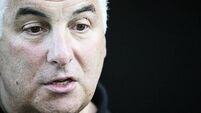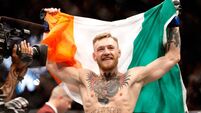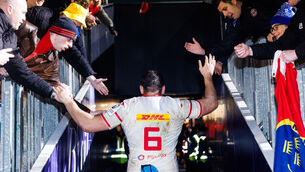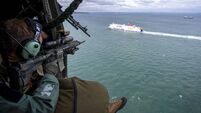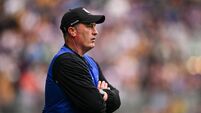In a League of its own
The result of the club’s latest battle with the Revenue Commissioners came perilously close to being the most devastating of all – a winding-up order on the back of an unpaid tax bill which, until injury time in the High Court yesterday afternoon, threatened to put the club out of existence with immediate effect. Now, they have until close of business next Wednesday to settle a debt of almost €400,000 – or face the activation of the winding up order 24 hours later.
That the club are confident they can meet the deadline is good news for football in Cork and the domestic game in general but that the Leesiders ended up in this situation at all can do nothing but accentuate the sense of recurring crisis in the League of Ireland.
The writing has been on the wall across the whole domestic game for some considerable time – and not just in recent years when other big names, like Shelbourne, Shamrock Rovers and 2007 champions Drogheda United have gone close to the edge.
In truth, if Cork City’s near-extinction was a bombshell, the explosion only came at the end of a very long, very slow-burning fuse.
When the subject is club football in Ireland, the past really is a different country. Forty years ago, the top League of Ireland clubs attracted huge crowds to watch part-time footballers who were the very best the sport had to offer in this country at the time.
In 1968, to give a vivid example, the FAI Cup Final saw competition specialists Shamrock Rovers beat league kingpins Waterford by three goals to nil. The official attendance in Dalymount Park that day was 39,000 — but, after a gate into the ground was broken down by fans attempting to gain access as kick off approached, it was generally accepted that somewhere in the region of 45,000 people ended up watching the game.
Co-incidentally, 1968 was also the year that a new Sunday afternoon televised football programme was inaugurated in England. Within just a couple of years, ITV’s ‘The Big Match’, a compendium of highlights from the weekend’s football, was eating into attendance figures for the live game here.
In terms of televised football, it represented the first sustained threat to the supremacy of the League of Ireland.
Suddenly, for soccer fans, it was no longer the only game in town. Now, instead of leaving the house to see revered local heroes like Shamrock Rovers’ Mick Leech, Cork Hibernians’ Miah Dennehy and Waterford’s Johnny Mathews in the flesh, Irish fans could watch international superstars like George Best, Rodney Marsh and Peter Osgood at the flick of a switch. (Ironically, some of the big names in English football, in the dying days of their careers, would fetch up on Irish pitches as clubs here desperately sought to boost falling attendances with a bit of imported, if fading, glamour).
Simultaneously, another 70s phenomenon, this one homegrown, began to exert added pressure on League of Ireland football. The success of the Dublin gaelic football team and the attendant surge in popularity which produced ‘Heffo’s Army’ had an immediate impact on devotion to soccer in the capital where, as a regular myself at Shamrock Rovers’ games throughout that decade, I can testify to the fact that many erstwhile Hoops supporters — having newly experienced the ‘Stretford End’ effect of standing on a packed Hill 16 — simply upped sticks to Croker, never to return.
Ever since, the story of the League of Ireland has been about a sport trying to eke out a living space between, on the one hand, the pull of enormously popular native games and, on the other, the massive appeal of English (and in the case of Celtic, Scottish) football.
Certainly, thanks to saturation television coverage, that appeal is now pretty global in reach but, in probably no other country in Europe, is its impact quite so invasive as it is in Britain’s nearest neighbour, a place where — as the weekly exodus by boat and plane underlines — many thousands of soccer fans effectively view clubs like Manchester United and Liverpool as their ‘home’ teams.
But if the League of Ireland struggled in vain to recreate the glory days and win back hearts and minds throughout the 80s and 90s, that is not to say that the game itself didn’t produce memorable occasions for the faithful along the way, as well as the odd seismic moment which threatened to transcend the norm and capture, once again, the popular imagination — as in 1991 when Cork City shook European football by drawing 1-1 with Bayern Munich.
But for every cherished high and false dawn, there were too many crushing lows, not the least of which was when Glenmalure Park went under the wrecking ball in 1987, condemning Shamrock Rovers, historically Irish football’s flagship club, to over 20 years of a nomadic existence.
Nor did the unprecedented success of the international team under Jack Charlton have any discernibly positive effect on the local game.
There was one brief stirring of optimism when, on the back of the popular hysteria surrounding Italia ‘90, some 22,000 people turned up to watch Shamrock Rovers debut at their then new home in the RDS in 1990. Unfortunately, an excruciatingly dull scoreless draw with Dublin rivals St Patrick’s Athletic did little to encourage the curious to return for a second look and even though the Hoops would go on to win a league title at the venue four years later, their average attendance rarely rose above a couple of thousand.
The onset of the Celtic Tiger would bring out the best and the worst in the domestic game. As the country grew dizzy in the boom time, Shelbourne led the domestic league in reaching for the stars.
Full-time professional football became the obsession. Shels thought big and bought big, assembling a side which would dominate the domestic game and, it was hoped, unlock the key to the riches represented by success in European competition.
They came agonisingly close in the memorable summer of 2004, drawing 25,000 to Lansdowne Road to watch them play Deportivo La Coruna in the Champions’ League. Shels held the Spanish giants to a 0-0 draw in Dublin but when they were beaten in the second leg, they fell one step short of qualification for the lucrative group stages of Europe’s premier club competition.
It was a classic example of so-near-and-yet-so-far away: Shelbourne had indeed made great strides but the final step had proved the hardest and most insurmountable of them all.
Worse, the heavy cost of the effort only became brutally apparent two years later when, under the weight of crippling debts and ongoing cash-flow problems, the club virtually imploded, the break-up of the team quickly followed by demotion to the second tier where, today, as an altogether leaner model, Shels are endeavouring to climb back into the top-flight.
The story of Shelbourne reads like a League of Ireland fable: the club who flew too close to the sun and barely lived to tell the tale.
And to varying degrees, it has also been the story of too many other clubs who have lived beyond their means in an era of heavy investment and spiralling wages which, despite significant increases in prize-money and sponsorship, bear little relationship to the reality of a sport which continues to struggle to secure the popular vote.
Since taking over the direct running of the league in 2007, the FAI have endeavoured to match the carrot of increased prize money with the stick of punitive sanctions for clubs which don’t keep their financial affairs in order.
But that Cork City have come close to collapse under the FAI’s watch, is hardly a ringing endorsement of the governing body’s efforts to whip the domestic game into shape. Worryingly too, league and cup holders Bohemians face an uncertain future after their plans to sell Dalymount Park were put in limbo by a combination of legal wrangles and the slump in the property market.
The bitter irony in all this is that the momentum behind full-time professionalism has produced significant and measurable improvements in standards on the field of play — as evidenced not only in some thrilling domestic games and high quality individual performances, but also in a handful of outstanding displays in European competition in recent years.
However, the sustained follow-through has never materialised and, now, in the teeth of a recession, the League of Ireland is belatedly learning the harsh lesson that it will have to cut its cloth, if not even to thrive, then merely to survive.
Shamrock Rovers would seem to provide a ray of hope. After going through its own near-death experience in 2005, the club emerged from examinership under the ownership of its loyal supporters.
Now, with a home to finally call its own in Tallaght — albeit as anchor tenants in a stadium owned by South Dublin County Council — Rovers are busy not only putting down roots in the community but also outstripping short-term predictions by challenging for a league title in their first season in their new home with a team which has been assembled at a fraction of the kind of costs incurred in recent years by the likes of Cork, Shels and Drogheda.
The buzz surrounding the recent visit of Real Madrid to Tallaght — and Rovers’ creditable performance in restricting the Galacticos to a narrow one-goal win — was a much-needed public relations shot in the arm for the League of Ireland. Yet, for all the excitement surrounding he event, surely only the most hopelessly romantic could legitimately dream now of a day when the two clubs might actually meet in real competitive European action.
For a growing number of seasoned observers of the game here, the fundamental lesson of the League of Ireland’s woes is that full-time professional football is simply not sustainable in this country. But if the League is to effectively revert to part-time status, then it’s equally hard to see how professional standards on the pitch can be maintained at the level which, however fleetingly, gave such high hopes of a European breakthrough over the past five tumultuous years.
In the end, the choice may be a stark one: between survival on a small scale and a mass extinction event.


